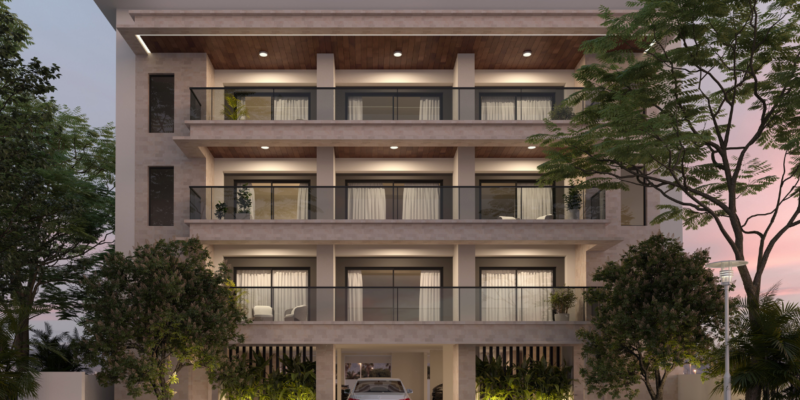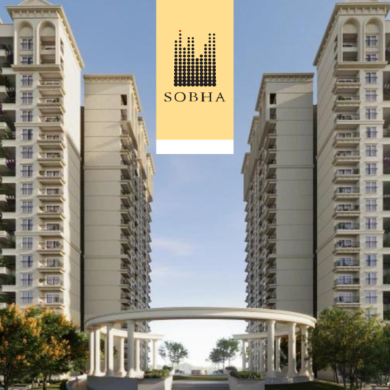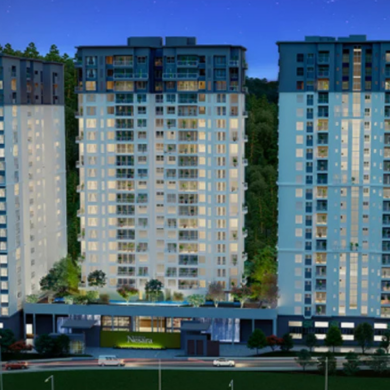
Builder floors are a notable and flexible housing option within the real estate industry. Also known as independent floors, these residential units are typically constructed by individual builders or developers as part of a low-rise structure. Each floor is an independent housing unit, offering residents privacy, autonomy, and customisation.
Gain valuable insights into the world of builder floors or independent builder floors, exploring their meaning, key differences from other housing types, and the pros & cons associated with choosing them as your next place to call home. This unique feature distinguishes builder floors from traditional apartments, making them an attractive choice for those who seek a balance between apartment living and the autonomy of a standalone house.
The importance of builder floors in real estate lies in their ability to provide a diverse range of housing options, catering to various preferences. Residents can enjoy the freedom to customise their living spaces and often benefit from more spacious interiors, which is particularly valuable in densely populated urban areas.
Builder floors not only are a great choice for homeowners but also offer investment potential due to their unique characteristics and the potential for higher resale or rental value. Additionally, they contribute to the local culture and heritage in certain regions, adding to their significance in preserving the architectural identity of neighbourhoods.
Table of Contents
Advantages of Builder Floors
-
Independence and Privacy:
Builder floors offer a higher degree of independence and privacy compared to traditional apartments. Each floor typically functions as a separate, self-contained unit with its own entrance, providing residents with a sense of autonomy akin to living in a standalone house. This added privacy can be particularly appealing to those who value a more secluded and personalised living environment.
-
Customization and Design:
One of the most notable advantages of builder floors is the opportunity for extensive customisation and design. Residents can personalise their living spaces to a significant extent – including interior layouts, finishes, and architectural modifications. This freedom to tailor the space to individual preferences is a unique selling point, making builder floors stand out in the real estate market.
-
Potential Investment Benefits:
Builder floors often have strong potential for investment benefits. The customisation and unique features of these properties can result in higher resale or rental value. Additionally, their individuality can make them attractive to a specific segment of the market, potentially leading to increased demand and property appreciation. This investment potential is a significant advantage for both homeowners and real estate investors looking for a property with long-term value.
Disadvantages of Builder Floors
-
Higher Initial Cost:
Builder floors can often come with a higher initial cost compared to standard apartments due to the customisation and larger living spaces they offer.
-
Maintenance Responsibility:
Homeowners are typically responsible for the maintenance and upkeep of their builder floor, which can involve additional costs & effort.
-
Limited Security:
Builder floors may have fewer security features compared to larger apartment complexes, such as dedicated security staff, gated entry, or surveillance systems. This can affect the overall security of the property.
-
Limited Shared Amenities & Community Facilities:
This may mean missing features like a community pool, gym, or common recreational areas, which are common in apartment complexes.
-
Potential for Noise and Disturbance:
While builder floors provide a level of independence, noise from neighbouring properties can be a concern. The level of privacy and insulation can vary, and noise disturbances might be harder to mitigate.
Builder Floor vs. Other Housing Options
Builder Floor vs. Apartments
Builder Floor |
Apartments |
|
| Ownership and Autonomy | You typically own a single floor or unit in a larger building. You have more autonomy and privacy compared to apartments in high-rise buildings. | Individual units are stacked on top of each other. You share common areas and amenities with other residents, which may reduce autonomy. |
| Customisation | Builder floors offer more customisation potential. You can personalise the interior layout, finishes, and design to a greater extent. | Apartment layouts and designs are standard, with limited customisation options. |
| Amenities and Facilities | Amenities are often limited to what is available within your individual unit or immediate surroundings, as builder floors tend to have fewer shared amenities. | Apartments often offer a wider range of shared amenities such as gyms, swimming pools, community spaces, and security services. |
Builder Floor vs. Villas
Builder Floor |
Villas |
|
| Size and Space | Builder floors typically offer more space and larger living areas than standard apartments, making them suitable for families. | Villas are standalone houses with more space than builder floors, both indoors and outdoors, offering a greater sense of independence. |
| Customisation | Builder floors offer customisation but within a shared building. Your design choices are subject to building guidelines. | Villas provide the most customisation options, allowing homeowners to modify the property extensively. |
| Maintenance Responsibility | Homeowners are responsible for the maintenance and upkeep of their individual floors. | Villa owners have full responsibility for maintaining both the interior and exterior of their property. |
Builder Floor vs. Independent Houses
Builder Floor |
Independent Houses |
|
| Ownership and Autonomy | Builder floors are part of a larger building, offering a balance between apartment living and the autonomy of an independent house. | Independent houses are standalone properties with complete autonomy, and often more outdoor space. |
| Customisation | Builder floors offer customisation opportunities within the confines of the building’s structure. | Independent houses offer the most extensive customisation options, with full control over both interior and exterior designs. |
| Maintenance Responsibility | Homeowners typically maintain their individual floors, and may share certain common areas with other residents. | Owners of independent houses are responsible for maintaining the entire property, both inside and outside. |
Understanding Builder Floors
Definition and Characteristics
Independent builder floors are a distinct housing arrangement where a single building is divided into separate, self-contained residential units, each occupying its own floor. These residential units, typically constructed by individual builders or developers, grant residents privacy, autonomy, and the freedom to personalise their living spaces. Each floor functions as an independent housing unit, often featuring its own entrance, setting it apart from traditional apartment living.
The defining characteristics of builder floors include their capacity for customisation, providing residents with the opportunity to tailor their homes to their preferences. They offer privacy like standalone houses, even as they may share amenities and security features. Builder floors are particularly appealing in urban areas due to their spacious living areas, and they often contribute to the local architectural and cultural heritage in specific regions, preserving the unique character of neighbourhoods.
Furthermore, they hold investment potential, as their individuality and customisation options can lead to higher resale or rental value, making them a noteworthy and adaptable housing option within the real estate market.
Assessing Your Needs
Before venturing into housing options like builder floors, a thorough self-assessment is imperative. Start by gauging your needs – encompassing lifestyle, preferences, and future plans. This involves evaluating the space requirements by factoring in family size and belongings. An equally vital factor is location, as it impacts proximity to work, schools, transportation, and essential amenities.
Your budget plays a pivotal role, not just for the initial purchase but also for ongoing maintenance and property-related expenses. Additionally, decide on the significance of privacy versus community living, and assess whether the builder floor aligns with your long-term plans.
Weighing Pros and Cons
Every housing option carries its own set of advantages & disadvantages, and builder floors are no exception. Key pros include the substantial customisation potential, a higher degree of privacy and autonomy compared to traditional apartments, more spacious living areas suitable for families, investment potential due to uniqueness, and the contribution to local architectural heritage in certain regions.
However, builder floors also come with cons such as increased maintenance responsibility, potentially limited shared amenities, higher cost than standard apartments, and limited availability.
How to Buy a Builder Floor?
Purchasing a builder floor involves a step-by-step process to ensure a well-informed and secure transaction. Define your requirements, including budget, location, and specific preferences. Research and find suitable listings through online platforms, real estate agents, and local classifieds. Arrange visits to inspect potential properties, and carefully evaluate factors like neighbourhood, amenities, and property condition.
After finding a suitable builder floor, negotiate the terms & price with the seller and make a formal offer. Ensure that the property has the necessary legal clearances & approvals. Hire a property lawyer to conduct due diligence, including a title search and inspection. Finalise the sale agreement, appraise the property, and secure financing if needed.
On the closing day, complete all legal & financial formalities, and take possession of the property. Register the property in your name and coordinate with the seller for a smooth transition. Seeking professional guidance from experts like real estate agents, property lawyers, and financial advisors is essential to navigate the complexities of the buying process.
10 Tips to Maintain a Builder Floor
Maintaining a builder floor is crucial to preserve its value, aesthetics, and functionality over time. Here are some valuable tips for maintaining a builder floor:
-
Regular Cleaning:
Establish a routine for cleaning, including floors, walls, windows, and fixtures. Regular maintenance prevents the buildup of dirt and grime.
-
Inspect for Repairs:
Periodically inspect the property for any signs of wear & tear, such as leaking pipes, electrical issues, or cracks. Address these repairs promptly to prevent them from escalating.
-
Paint and Touch-Ups:
Refresh the paint and perform touch-ups as needed, to maintain the aesthetic appeal of your builder floor. A fresh coat of paint can make a significant difference.
-
Keep Drainage Clear:
To prevent water damage, ensure that drainage systems inside and outside are clear of debris and are functioning correctly.
-
Pest Control:
Implement pest control measures to prevent infestations. Regular inspections and necessary treatments can keep pests at bay.
-
Maintain Electrical and Plumbing Systems:
Periodically check your electrical and plumbing systems for any issues. Replace faulty switches, outlets, or fixtures, as necessary.
-
Roof and Terrace Maintenance:
If your builder floor includes a terrace or roof, inspect it regularly for leaks or damage. Ensure proper waterproofing to prevent water seepage.
-
HVAC System Care:
Maintain heating, ventilation, and air conditioning (HVAC) systems by changing filters and scheduling professional servicing as needed.
-
Security and Safety:
Ensure that security features, such as locks and alarms, are in good working condition. Replace any faulty components to maintain the safety of your property.
-
Regular Pest Control:
Implement periodic pest control measures to prevent infestations. Routine inspections and necessary treatments can help keep pests at bay.
By following these tips, you can ensure that your builder floor remains in good condition, retains its value, and provides a comfortable & safe living environment. Regular maintenance is an investment in the long-term well-being of your property.
Future Trends in Builder Floor Living
A dynamic shift towards technology, sustainability, and flexible living solutions marks the future of builder floor living. Smart homes are expected to become the norm, with automation systems enhancing convenience and energy efficiency. Sustainable, eco-friendly features like energy-saving appliances and green building materials are poised to gain prominence, aligning with the global push towards environmental responsibility.
Flexibility in layouts and the ability to cater to multi-generational living will become more common, allowing builder floors to adapt to diverse family structures and lifestyles. The customisation trend is set to flourish, empowering homeowners to personalise their living spaces. Community amenities, advanced security measures, and technology-driven property management are set to elevate the living experience on builder floors.
Moreover, various architectural styles and a focus on health & well-being features will cater to a broader range of tastes & needs. In summary, builder floors of the future will blend modern technology, sustainable living, and adaptability to create well-connected, eco-conscious, and versatile living spaces for residents.
SOBHA Builders Floor in Gurgaon
SOBHA Limited, a prominent real estate developer in India, has made a significant mark in the real estate sector. After the success of SOBHA City and International City, Builder Independent Floors in Gurgaon is their latest venture. Your family will discover an unmatched sanctuary within the safe and intimate villa community of International City Gurugram, that is spread over 150 acres.
Take advantage of the highly desired opportunity to reserve a complete floor – a mark of grandeur and exclusivity. Each floor is a lavish retreat, complete with a private entrance, a roomy living and dining area appropriate for the largest parties, and a kitchen that has been painstakingly constructed to satisfy your culinary needs. Spacious balconies and patios invite leisure & relaxation, and the well-proportioned bedrooms provide enough area for your family to feel comfortable.
These builder floors for sale in Gurgaon completely reimagine luxury living by fusing the allure and exclusivity of villa living with the easy accessibility of an apartment. Nestled within rich, luscious foliage, this is your very own paradise.
Final Thoughts
Independent builder floors represent a unique and attractive housing option in the real estate landscape. These self-contained, customisable living spaces offer the best of both worlds, combining the privacy and autonomy of standalone houses with the conveniences of modern apartment living. Builder floor for sale in Gurgaon allows homeowners to shape their living spaces to their specific preferences, making them a versatile choice for those who value personalisation.
The future of builder apartments also holds promise, with trends pointing towards increased technological integration, sustainability, flexibility in layouts, and community-oriented amenities. Whether you are searching for a comfortable and private family residence or a unique investment opportunity, luxury builder floors in Gurgaon can be the answer.
The key lies in assessing your needs, understanding the pros and cons, and staying informed about evolving real estate trends. With careful consideration and due diligence, these distinctive living spaces can provide an excellent, customisable, and comfortable home for those seeking a housing option that stands out.
FAQs
1. What are the benefits of a builder floor?
Benefits of a builder floor are customisation to suit your preferences, higher level of privacy and autonomy than apartments, spacious living that is ideal for families, and unique features & customisation that can increase resale or rental value.
2. What are the disadvantages of a builder floor?
The disadvantages of a builder floor are responsibility of maintenance & repairs, fewer shared amenities compared to large apartment complexes, higher cost due to customisation and space, and availability in limited locations.
3. What is a builder floor in Gurgaon?
A builder floor in Gurgaon is a self-contained residential unit within a larger building or property. It is typically constructed by individual builders or developers, and often includes one or more floors with separate entrances, offering residents a degree of privacy & customisation.
4. Is it good to invest in builder floor?
It is good to invest in a builder floor, especially if you seek a unique property with customisation potential. It may have good resale or rental value due to its distinctive features, but it is essential to consider the location, local market conditions, and your long-term investment goals.
5. Why builder floors are cheaper?
Builder floors may be cheaper compared to high-rise apartments in some cases, because they often have fewer shared amenities, which can reduce maintenance costs and homeowner association fees. However, the cost varies depending on the location and level of customisation.
6. Which floor is best to buy?
Best floor to buy in a builder floor property depends on your preferences. Ground floors offer easy access and sometimes come with a garden or open space. Higher floors may provide better views and security but involve climbing stairs or taking elevators.
7. What is difference between apartment and builder floor?
The difference between apartment and builder floor is the level of customisation and autonomy. Builder floors are typically self-contained units within a larger property, offering more privacy and the option of personalisation. On the other hand, apartments are part of a shared building with limited customisation options.







